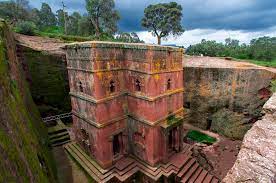In the Middle Ages, the evidence suggests that Ethiopia was a Christian nation surrounded by hostile Muslim territories. Medieval manuscripts explain that there was a Solomonic dynasty in Ethiopia—that is, the heirs of King Solomon, descended from the son born to the Queen of Sheba. Unprovable, but it would explain the Christian presence in that part of the world. In fact, "Dawit I" is what he is called in the West; Ethiopian sources call him "Dawit II," because they consider the first "Dawit" to be King David.
One of the members of the heirs of Solomon was Dawit I (1382-1413). There are stories that Dawit led armies against his Muslim neighbors to the east, and that he also advanced against the emir that held Egypt at the time, until the emir asked the Patriarch of Alexandria to tell Dawit to cease in order to preserve the peace in the kingdom.
There is also reason to believe that he was in communication with Europe, making a request to Venice to send him artisans for the beautification of his realm. Documentary evidence exists that this request reached Venice in June 1402, and that 5 artisans did leave for Ethiopia.
We don't know if they ever arrived, but we can turn to circumstantial evidence. The Portugese missionary and explorer, Francisco Álvares (c.1465-c.1540), claims to have seen a Venetian chalice during his six years in Ethiopia. Also, an unsigned manuscript exists that documents a trip from Venice to Rhodes, Cyprus, Jerusalem, Cairo, and finally to the court of Prester John at Shewa, a region in Ethiopia that has Addis Ababa (Ethiopia's modern capital) at its center. (Prester John was often said to have his kingdom "in India"; for most Europeans, however, geography outside of Europe was a pretty vague topic. You can learn more about Prester John here and here). This itinerary shows an unambiguous knowledge of the stages of a journey from Venice to Ethiopia, suggesting that perhaps the legend of Dawit's interest in European artwork was based on truth.
Alas, Dawit died young, kicked in the head by a horse. He is interred at a monastery on Daga Island in Lake Tana, the source of the Blue Nile, along with other members of his dynasty.
